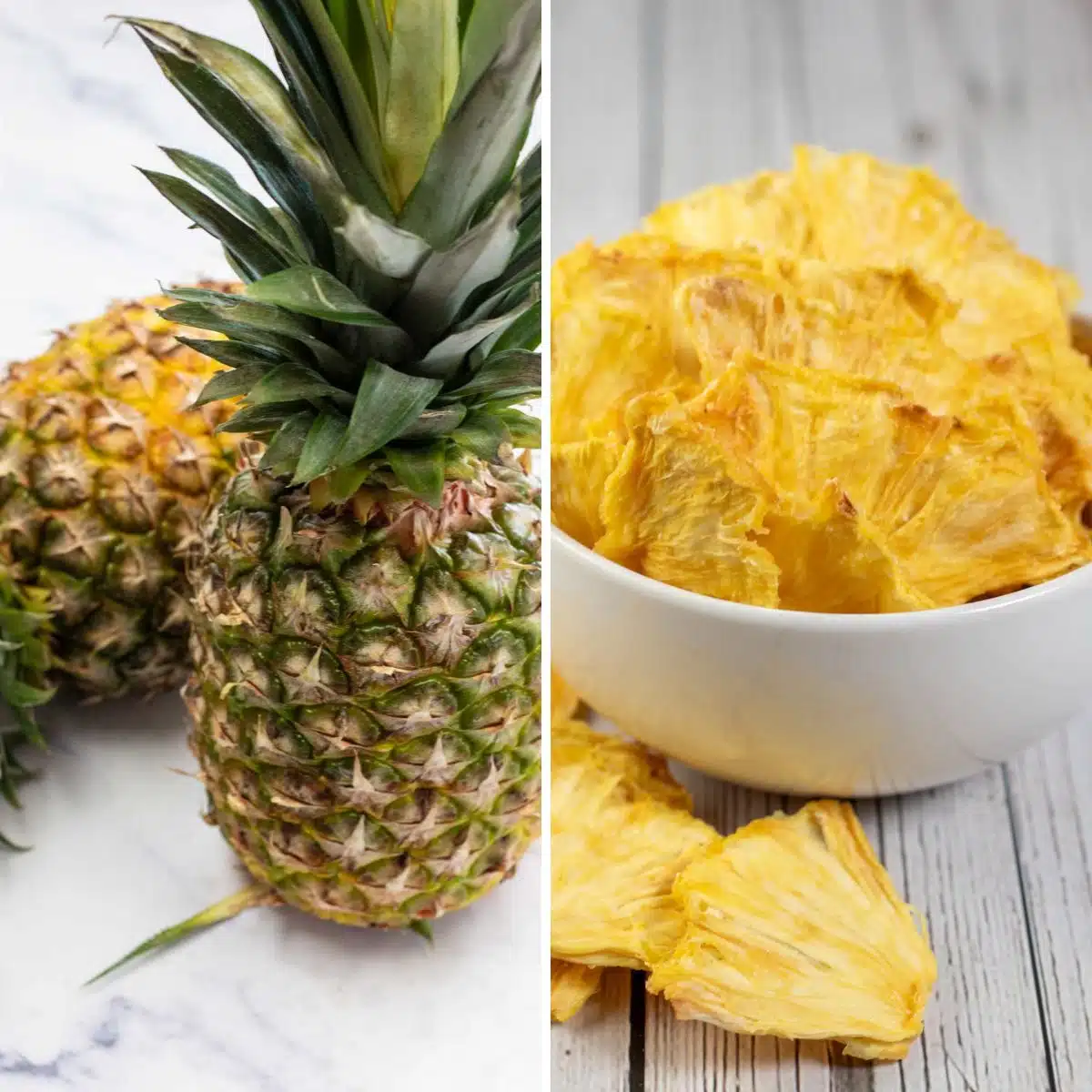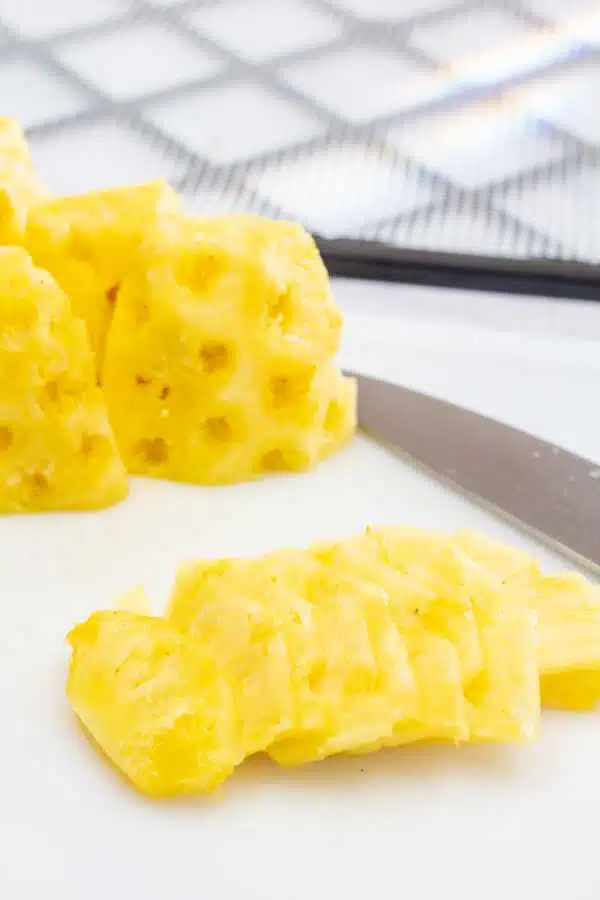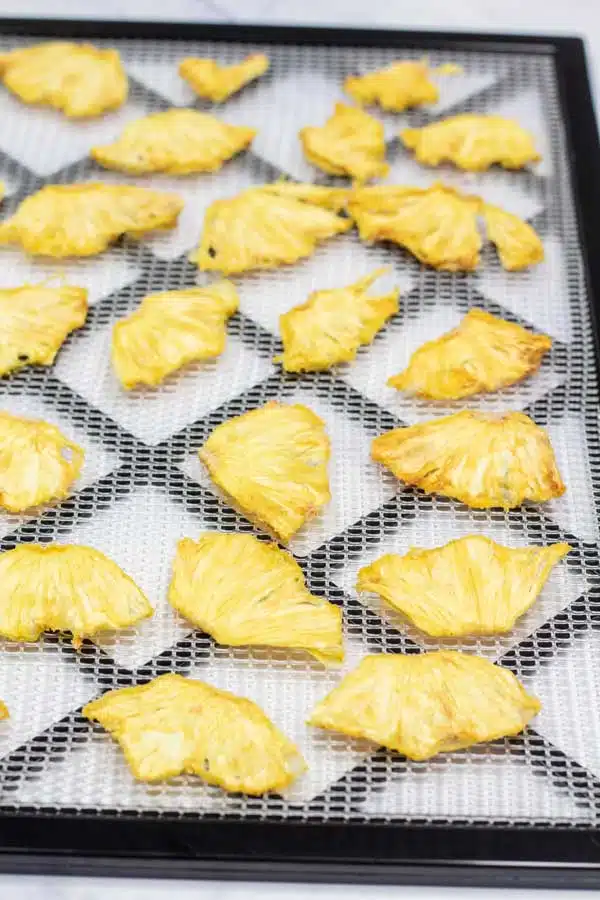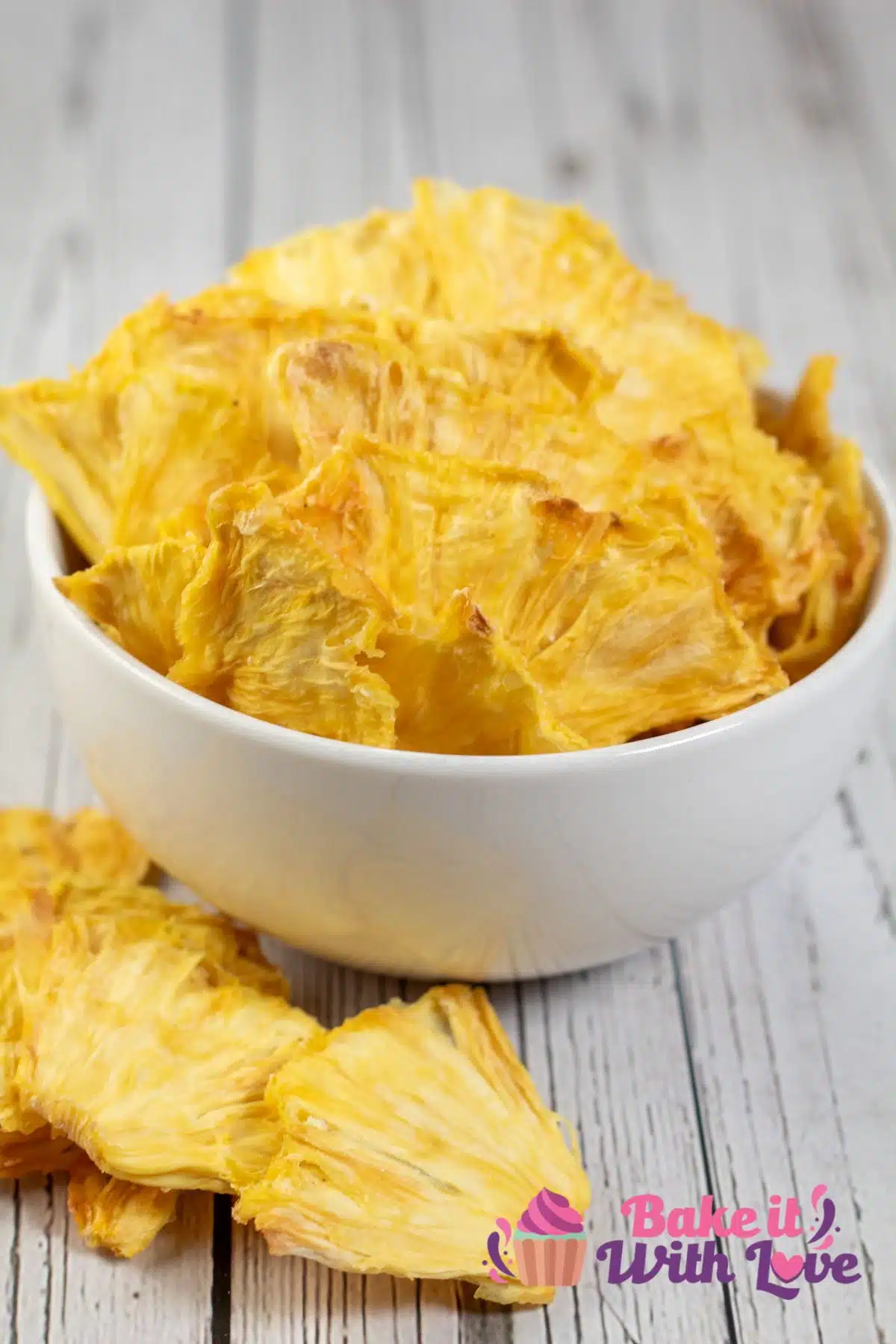Dehydrated pineapple is not only simple to prepare, but it also makes a wonderfully delicious treat or snack! These delicious and portable bite-sized pineapple pieces are perfect for on-the-go, kids, traveling, and more! Plus, when stored properly, they can easily stay fresh for up to a year!
Homemade Dehydrated Pineapple Recipe
I absolutely love pineapple. In fact, it's probably up there on my list of favorite fruits. It is sweet, tropical, and oh-so-tasty! However, I will admit that it isn't quite as simple to eat as just picking up an apple and taking a bite.
It needs to be cored, peeled, and sliced before you can dig in, which isn't necessarily quick (even with a pineapple corer). Now, with this easy dehydrated pineapple recipe, you'll be able to do all of the prep work only once and have dried pineapple on hand whenever you're in the mood for it!

Jump to:
🥘 Dehydrated Pineapple Ingredients
The beauty of dehydrating pineapple is that it doesn't brown, so the only thing you need is the pineapple itself! Choose one that is perfectly ripe!

- Pineapple - 1 large pineapple. Make sure it is nice and ripe so that your dried pineapple has the best flavor! Of course, you can dehydrate canned pineapple as well.
*Be sure to see the free printable recipe card below for ingredients, exact amounts & instructions with tips!*
🔪 How To Dehydrate Pineapple
The hardest part of dehydrating pineapple is just cutting it up into small pieces. You can use a pineapple corer if you have one, but it isn't necessary. You'll want a cutting board, a sharp knife, and your dehydrator.
This recipe is for dehydrating one full pineapple, which is the same as about 12 servings.





Prepare the Pineapple
- Wash. Wash 1 large pineapple under cold water, transfer it to a cutting board, and cut off the top and bottom.
- Trim. Lay the pineapple on its side and cut it in half so that you have two shorter halves of the barrel (as opposed to lengthwise). Then, trim the peel off of the sides and cut each section into quarters.
- Remove the eyes. Use a paring knife or vegetable peeler with a coring tip to remove the eyes and then slice off the wedge-shaped core.
- Cut. Cut the pineapple into smaller pieces that are about ¼-inch thick.
Dehydrate the Pineapple
- Prepare. Place the pineapple pieces into the dehydrator tray, making sure to leave about ½ inch of space in between them.
- Dehydrate. Turn on the machine to 135°F (57°C) and allow the fruit to dehydrate. It will take about 10-12 hours in total to fully dehydrate, but you'll want to flip all of the pineapple pieces over at about the 5-hour mark. *Rotating your racks will also help to ensure that the pineapple dries at the same rate.
- Cool. Once crisp and dry, remove the pineapple and allow it to cool to room temperature.
If you're a fan of dehydrating fruit, make sure to check out my recipe for dehydrated watermelon jerky! It's just as tasty as this pineapple! Enjoy!

💭 Angela's Pro Tips & Recipe Notes
- Some pineapple pieces will dry out and dehydrate faster than others, so go ahead and remove them as they finish.
- The drying process concentrates the natural sugars in the pineapple, so use a sweet and ripe pineapple for the tastiest results!
- Most fruit is dehydrated at a low temperature of 135°F (57°C). Since pineapple doesn't brown, there are no other ingredients necessary!
- Rotate your racks when you flip over the pineapple pieces after 5 hours to ensure that all of the pieces are drying at the same rate.

🥡 Storing
Place the cooled pineapple pieces into a sealed container or Ziploc bag and keep them at room temperature for up to 2 weeks.
Conditioning the Pineapple
Place your pineapple pieces into a clear container or glass jar (I recommend storing them in smaller portions to avoid opening the jars frequently and introducing moisture). Check the container every day for any signs of moisture. If there is moisture, place the pieces in the container back into the dehydrator and dry them some more. Then, restart the process.
After a week, when there are no signs of moisture, you can store them in an airtight container or vacuum seal them for up to one year. This process is called conditioning the fruit. *Note that if at any point during conditioning, you find mold, you will need to toss the entire container of pineapple.
>>>>See all of my recipes here<<<<
❓ Recipe FAQs
Yes! You can easily dehydrate fresh or canned pineapples as well as in rings or in smaller slices. The natural sugar makes it super sweet, but with no mess from the juice! This makes it an ideal snack for when you're on the go!
When fruit is dehydrated, the water is literally removed from it. As a result, all of the calories and sugars are concentrated in a smaller area, making it taste sweeter!
When you condition your dried pineapple and store it properly, it can easily last for up to a year! Just make sure it is sealed in a container or glass jar and stored in a cool, dark place (such as a cabinet or pantry).

🍎 More Tasty Snacks
- Dill Pickle Dip - A pickle-flavored dip that pairs well with chips or veggies!
- Baked Chicken Wings - Chicken wings that are prepared in the oven before being tossed in your favorite sauce!
- Baked Mac & Cheese Bites - Tasty bite-sized portions of macaroni and cheese that are crisp on the outside and cheesy on the inside!
- Grape Jelly Meatballs - Sweet meatballs that are perfect for hosting!
- Pretzels - Traditional soft pretzels are easier to make than you might think!
- Stovetop Popcorn - Salty and savory popcorn is whipped up in a snap on the stovetop!
Do you love a recipe you tried? Please leave a 5-star 🌟rating in the recipe card below and/or a review in the comments section further down the page.
Stay in touch with me through social media @ Pinterest, Facebook, Instagram, or Twitter! Subscribe to the newsletter today (no spam, I promise)! Don't forget to tag me when you try one of my recipes!
📖 Recipe Card
Dehydrated Pineapple
Ingredients
- 1 large pineapple (ripe, peeled, cored, and cut into small pieces)
- water (for rinsing)
(Note: 2x or 3x only changes the ingredient list)
Instructions
Prepare the Pineapple
- Wash your pineapple under cold water, transfer it to a cutting board, and cut off the top and bottom.
- Lay the pineapple on its side and cut it in half so that you have two shorter halves of the barrel (as opposed to lengthwise). Then, trim the peel off of the sides and cut each section into quarters.
- Use a paring knife or vegetable peeler with a coring tip to remove the eyes and then slice off the wedge-shaped core.
- Cut the pineapple into smaller pieces that are about ¼-inch thick.
Dehydrate the Pineapple
- Place the pineapple pieces into the dehydrator tray, making sure to leave about ½ inch of space in between them.
- Turn on the machine to 135°F (57°C) and allow the fruit to dehydrate. It will take about 10-12 hours in total to fully dehydrate, but you'll want to flip all of the pineapple pieces over at about the 5-hour mark. *Rotating your racks will also help to ensure that the pineapple dries at the same rate.
- Once crisp and dry, remove the pineapple and allow it to cool to room temperature.
Notes
- Some pineapple pieces will dry out and dehydrate faster than others, so go ahead and remove them as they finish.
- The drying process concentrates the natural sugars in the pineapple, so use a sweet and ripe pineapple for the tastiest results!
- Most fruit is dehydrated at a low temperature of 135°F (57°C). Since pineapple doesn't brown, there are no other ingredients necessary!
- Rotate your racks when you flip over the pineapple pieces after 5 hours to ensure that all of the pieces are drying at the same rate.
- For short-term storage: Place the cooled pineapple pieces into a sealed container or Ziploc bag and keep them at room temperature for up to 2 weeks.
- For long-term storage: Place your pineapple pieces into a clear container or glass jar (I recommend storing them in smaller portions to avoid opening the jars frequently and introducing moisture). Check the container every day for any signs of moisture. If there is moisture, place the pieces in the container back into the dehydrator and dry them some more. After a week, when there are no signs of moisture, you can store them in an airtight container or vacuum seal them for up to one year. This process is called conditioning the fruit.



Comments
No Comments